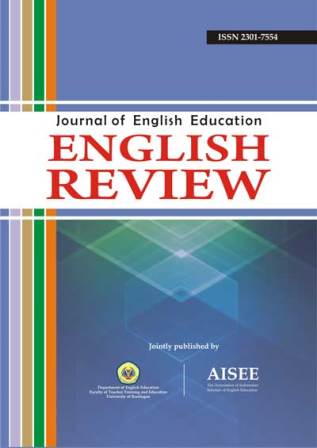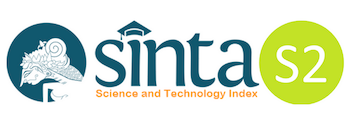Cohesive Devices In EFL Students’ Expository Writing
Abstract
This study aims to investigate the use of cohesive devices in students’ expository writing. In particular, the study focuses on types of cohesive device used by the students and how cohesive devices contribute to their writing. This study employs qualitative research through a case study design. Public senior high school in Kuningan is chosen as the site for this study. Nine students of twelfth grade are involved in the study as the respondents. Documents of nine students’ expository writings are the data of this study. The data are analyzed by using the concept of cohesive devices proposed by Halliday and Hasan (1976) which covers reference, substitution, ellipsis, conjunction, and lexical cohesion. Analyses show that the respondents only use four cohesive devices in their writing i.e. reference, substitution, conjunction, and lexical cohesion. These devices also contribute to the process of keeping track of the participants, avoiding repetition and text redundancy, enhancing logical connection between parts of text, and engaging the readers to the core argument of the text. The study infers that it is still problematic although most of the students apply many cohesive devices in their writing. This is because students have not received sufficient training concerning how to use appropriate cohesive devices. Therefore, they should be guided to utilize appropriate cohesive devices in their writing.
Keywords: cohesive devices, cohesion, EFL students, expository writing, case studyReferences
Brostoff, A. (1981). Coherence: “Next to†is not “connected to.†College Composition and Communication, 32 (2), 278–294.
Butt, D; Fahey, R; Feez, Spinks, S; & Yallon, C. (2006). Using Functional Grammar: An Explorer’s guide. Sydney, Australia: National Centre for English Language Teaching and Research.
Buttler, C. S. (1985). Systemic Linguistics: Theory and Applications. London, England: Bats ford Academic and Educational.
Chan, S. W. K.; Thou, B. K.; and Choy, C. F. (2000). Textual Information Segmentation by Cohesive Ties. [Online]. Available: http://aclweb.org/anthology/Y/Y00/Y00-1006.pdf. Retrieved on June 9 2015.
Cook, G. (1992). Discourse. Oxford, England: Oxford University Press.
Eggins, S. (1994). An Introduction to Systemic Functional Linguistics. London, England: Pinter Publisher.
Eggins, S. (2004). An Introduction to Systemic Functional Linguistics (2nd edn). London, England: Continuum.
Emilia, E. (2012). Pendekatan Genre-Based dalam Pengajaran Bahasa Inggris: Petunjuk Umum Guru. Bandung, Indonesia: Rizqi Press.
Gerot, L and Wignell, P. (1994). Making sense of Functional Grammar. Sydney, Australia: Antipodean Educational Enterprises.
Halliday, M. A. K. & Hasan, R. (1976). Cohesion in English. London, England: Longman.
Halliday, M. A. K. (1994). Introduction to Functional Grammar. London, England: Edward Arnold.
Halliday, M. A. K., & R.Hasan. (1989). Language, Context, and Text: Aspects of Language in a Social-Semiotic Perspective. Oxford, England: Oxford University Press.
Halliday, M.A.K. & Christian M.I.M. Matthiessen. (2004). An Introduction to Functional Grammar. 3rd, revised edition. London, England: Edward Arnold.
Halliday, M.A.K. & Matthiessen, C.M.I.M. (2004). An Introduction to Functional Grammar (3rd. ed.). London, England: Hodder Arnold.
Hoey, M. (1991). Patterns of lexis in text. Oxford, England: Oxford University Press.
Holloway, D. W. (1981). Semantic Grammars: How they can help us teach writing. College Composition and Communication, 32 (2), 205–218.
McArthur, T. (1996). Oxford Companion to the English Language. Oxford, England: Oxford University Press.
McCarthy, M. (1991). Discourse analysis for language teachers. Cambridge, England: Cambridge University Press.
McShane, M. J. (2005). A Theory of Ellipsis. Oxford, England: Oxford University Press.
Paltridge, B. (2006). Discourse Analysis: An Introduction. London, England: Continuum.
Sainton, R. J. (2006). Words and Thoughts: Subsentences, Ellipsis, and the Philosophy of Language. Oxford, England: Oxford University Press.
Salkie R. (1995). Text and discourse analysis. New York, NY: Routledge.
Thompson, G. (1996). Introducing Functional Grammar. London, England: Edward Arnold.
All articles published in English Review: Journal of English Education (ERJEE) are licensed under the Creative Commons Attribution 4.0 International License (CC BY 4.0).
Copyright Ownership
Authors retain the copyright of their articles and grant ERJEE the right of first publication. The journal is granted a non-exclusive license to publish, reproduce, and distribute the article in any format, medium, or platform, provided that proper credit is given to the original authors.
License Terms – CC BY 4.0
Under the Creative Commons Attribution 4.0 International License, others are free to:
- Share — copy and redistribute the material in any medium or format
- Adapt — remix, transform, and build upon the material for any purpose, even commercially
As long as they:
- Provide appropriate credit to the original author(s) and source
- Provide a link to the license (https://creativecommons.org/licenses/by/4.0/)
- Indicate if any changes were made
There are no restrictions on the reuse, reproduction, or adaptation of published articles as long as attribution is properly given.
Author Warranties
By submitting a manuscript to ERJEE, authors confirm that:
- The work is original and does not infringe any existing copyright.
- The manuscript has not been previously published and is not under consideration elsewhere.
- All sources and references are appropriately acknowledged.
- Necessary permissions have been obtained for any copyrighted materials used.









